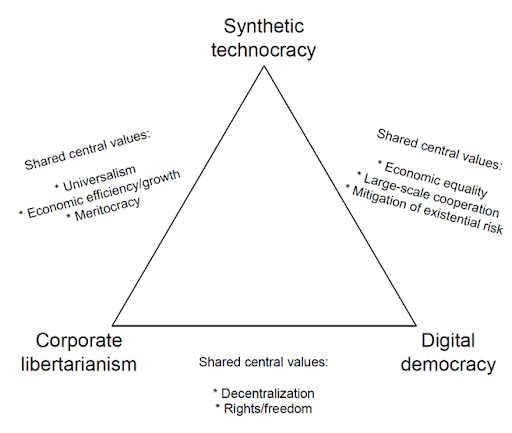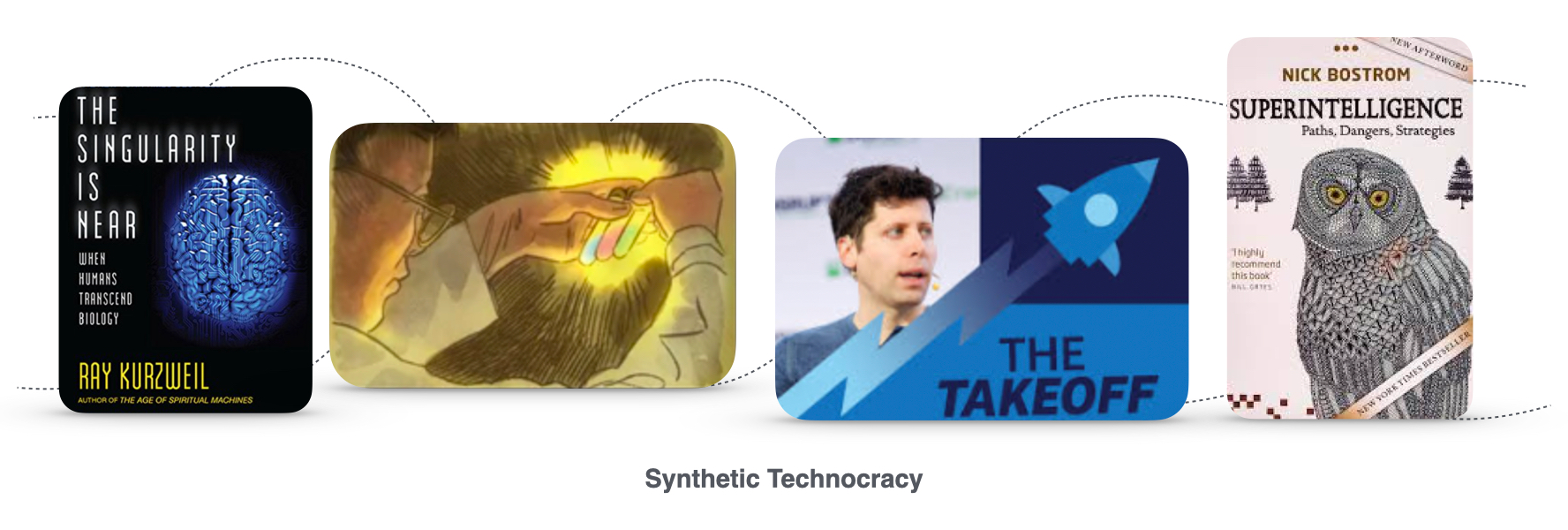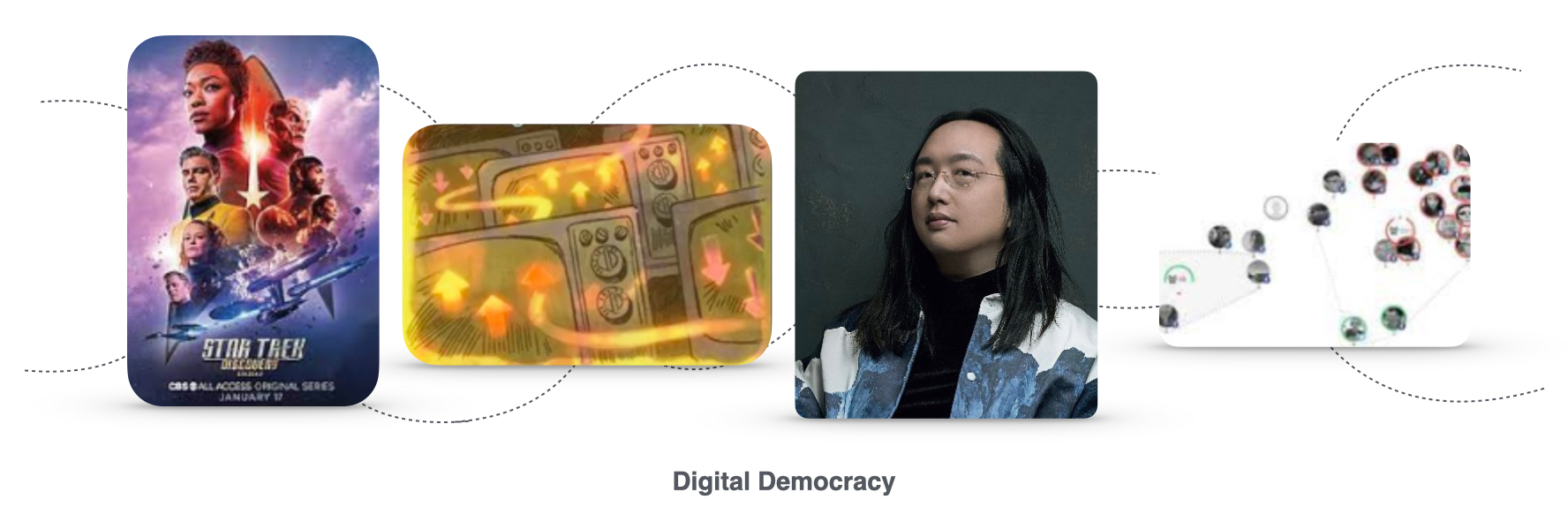Political Ideologies for the 21st Century
E. Glen Weyl
February 17, 2022

Whatever their differences, there seems to be broad agreement that we’re in a moment of political flux and that the debates of today are unlikely to persist in the coming decades. Some see an inevitable future of world-spanning super-intelligences and others radical crypto-powered decentralization. But you don’t have to embrace such determinism to believe (like Yuval Noah Harari) that only ideologies that have a coherent vision of the future of technology (just as Fascism, Communism and Democracy did in the 20th century) are likely to thrive.
A natural place to look for candidates for such technology-ideology pairs is Sid Meier’s Civilization, the best-selling strategy game of all time. The game has usually featured a variety of types of government to choose from: for example, in the Classical era Oligarchy, Classical Republic or Autocracy. Yet the latest expansion of the latest iteration of the game (Gathering Storm for Civ VI) projects into the future, offering a choice of Corporate Libertarianism, Digital Democracy, or Synthetic Technocracy.
Without taking a computer game too seriously, there is a logic to the way they carve up ideological space. In this document, I take their thinking and run with it, attempting to be fair to the self-understanding of each group and thus to welcome collaboration and critique from those who feel they generally identify with the camps. At the same time, I primarily wrote this document, and no one will be confused about which camp I identify with; last week I released something of a mission statement for Digital Democracy/Plurality/pluralism. As with any classifications of political beliefs, most people will find themselves somewhere in the middle of these groupings (as pictured in the diagram below) and many will find that even the space spanned by them captures only some elements of their views. Nonetheless, I believe classification is useful to allow those outside these debates about the future of governance an entry point into them. Debates about a distant future are often confusing and obscure, so I hope this may help simplify them.

Corporate Libertarianism

Description: Corporate Libertarians see digital technology as a pathway to liberate individuals from dependence on bureaucracy, collective organization, and coercion. They see cryptography and algorithmic coordination protecting of “negative liberties” of, e.g., speech and property untraceably, preventing collective sovereignties from impeding their exercise. They admire the transformative potential of entrepreneurial founders and hope to extend their domain to those usually covered by politics, like cities or nations. They view the decline of pre-digital social institutions (e.g. nation-states, “legacy” corporations”, unions, etc.) as inevitable, desirable and imminent. They see financial relationships, mediated by capitalist markets and based on profit, as the future in most domains.
Adjacent concepts: Individual sovereignty, exitocracy, Neoreaction (NRx), Dark Enlightenment, anarcho-capitalism, BitCoin maximalism, crypto maximalism, cypherpunk, Bronze Age Mindset, techno-libertarianism
Civic that unlocks it in Civ VI: Venture Politics
Strengths in Civ VI: Military, commercial, productive
Weaknesses in Civ VI: Science
Values: Decentralization, individualism, freedom, entrepreneurship, choice, capitalism, exit
Site of sovereignty: Individuals, commercial enterprises, tightly aligned communities.
Favorite forms of organization: Capitalist markets, start-up ventures, charismatic personalism
Inspiring fiction: Ayn Rand, Star Wars, Neal Stephenson (interpreted as utopian)
Canonical texts: The Sovereign Individual by Davidson and Rees-Mogg, “Silicon Valley’s Ultimate Exit” by Srinavasan, Unqualified Reservations by Moldbug, Zero to One by Thiel with Masters, The Jacobite, Snowcrash by Neal Stephenson, Declaration of the Independence of Cyberspace by John Perry Barlow
Leading figures: Peter Thiel, Balaji Srinavasan, Marc Andreessen, Nick Land, Curtis Yarvin, Patri Friedman
Favorite technologies: Blockchains, cryptography, seasteading, metaverse
Model cases: Cryptoeconomy, pre-2017 Hong Kong
Affiliation with standard political spectrum: Right-wing, especially techno-libertarian tradition.
Relationship to Silicon Valley tech scene: Accelerationist/ambivalent for lack of commitment to their strength.
Foils/bêtes noires: Chinese Communist Party (CCP); progressivism/wokeism; tech critics, luddites and technological conservatives; politics
Affiliated organizations/initiatives: Thiel Foundation; a16z, Founders Fund, Seasteading Institute, Pronomos Capital
Closest contemporary US political leaders: Donald Trump (adjacent), Blake Masters, Josh Hawley, JD Vance
Future of art: NFTs, art as object of economic value
Synthetic Technocracy

Description: Synthetic Technocrats expect the arrival of Artificial General Intelligence (AGI), machines that outperform humans on all economically relevant tasks at minimal cost, in the coming decades. They believe it will effectively end economic scarcity and the need for most humans to work. They see the major problems of social organization as both achieving this outcome quickly and reckoning with the risks it poses, especially the potential existential threat of misaligned AGI objectives and the maldistribution of the economic abundance AGI enables. They view the solution to these problems as technical in nature and hope adequate solutions to them will help resolve a range of other existential risks, especially those related to interpersonal human conflict. They see science and technology as the path to solving most problems.
Alternative nomenclature: AI Singularity, automated luxury communism, AI abundance, AI maximalism, universal basic income, post-scarcity
Civic that unlocks it in Civ VI: Optimization imperative
Strengths in Civ VI: Green energy, economics, resource management
Weaknesses in Civ VI: Culture
Values: Optimization/optimality, abundance, science, rationality, alignment, long-termism, efficacy/efficiency, economic equality, meritocracy
Site of sovereignty: Global humanity or traditional nation states
Favorite forms of organization: Academic institutions, research collaborations, bureaucracies, blogs
Inspiring fiction: Isaac Asimov, Iain Banks, Brave New World by Huxley, Harry Potter and the Method of Rationality by Yudowkowsky
Canonical texts: The Singularity is Near by Kurzweil, Superintelligence by Bostrom, “Moore’s Law for Everything” by Altman, Less Wrong blog, Overcoming Bias blog, Slate Star Codex blog
Leading figures: Sam Altman, Eliezer Yudkowsky, Stuart Russell, Reid Hoffman, Matthew Bruenig, Scott Alexander, Kai-Fu Lee, Feng Xiang (Chinese faction), Ezra Klein, Steven Pinker, Cass Sunstein
Favorite technologies: Artificial intelligence, brain emulation/whole brain uploads,
Model cases: Singapore, People’s Republic of China (Chinese faction), GPT-3, South Korea
Affiliation with standard political spectrum: Pro-tech left
Relationship to Silicon Valley tech scene: Orthodox allied
Foils/bêtes noires: Fossil fuel firms, weapons manufacturers, populism, misinformation, anti-science, neo-luddism
Affiliated organizations/initiatives: Open AI, Deep Mind, Machine Intelligence Research Institute, Future of Humanity Institute, Center for Human-Compatible Artificial Intelligence, Center for Effective Altruism, GiveWell, World Economic Forum
Closest US political leaders: Andrew Yang
Digital Democracy

Description: Digital Democrats locate the promise of digital technology in its capacity to empower the peaceful coexistence and collaboration of diverse and distributed communities. They center socio-technical systems (patterns of connections between tools, culture and political economies) over purely technical ones and thus celebrate a range of technologies serving democratic social organization (e.g. VR as a path to empathy, statistical text summarization to empower large scale deliberation, new political economic mechanisms that encourage cooperation). They seek to proliferate and diversify sites of social cooperation, while cooperating with and strengthening “legacy” loci of legitimacy. They seek a future managed by a diverse range of democratically governed communities cooperating in a subsidiary manner across scales.
Adjacent concepts: Plurality, digital pluralism, digital dignity, 21st century participatory democracy, fork-and-merge government, Wiki Government
Civic that unlocks it in Civ VI: Distributed sovereignty
Strengths in Civ VI: Culture, diplomacy and development
Weaknesses in Civ VI: Military
Values: Pluralism, compromise, deliberation, participation, democracy, self-government, voice
Site of sovereignty: Distributed, intersecting social groups, both old and new (e.g. data coops)
Favorite forms of organization: Civil society, social sector, cooperatives, local governments
Inspiring fiction: Star Trek, Ursula Le Guin, Octavia Butler, Malka Older, Kim Stanley Robinson
Canonical texts: Audrey Tang’s communications, Who Owns the Future? By Jaron Lanier, “Cryptocities” by Vitalik Buterin, Wiki Government by Noveck, Radical Markets by Posner and Weyl
Leading figures: Audrey Tang, Jaron Lanier, Daniel Schmachtenberger, Toomas Hendrik Ilves, Danielle Allen, Eli Pariser, Yochai Benkler, Nathan Schneider, Ethan Zuckerman, Glen Weyl, Tristan Harris, Astra Taylor, Cory Doctorow, Devon Zuegel, Lucy Bernholz, Pia Mancini, Xiaowei Wang, Julius Krein, Francesca Bria, Mariana Mazzucato
Favorite technologies: Personal computing, packet switching/public internet, wikis, digital deliberation, federated learning, distributed identity, public digital currencies, mesh networks and distributed computation, empathetic VR, cooperative mechanisms
Model cases: Estonia, Taiwan (Republic of China), Wikipedia
Affiliation with standard political spectrum: Broad center
Relationship to Silicon Valley tech scene: Ambivalent, want balance between governance and development
Foils/bêtes noires: Big tech, CCP, Singularity thinking, authoritarianism
Affiliated organizations/initiatives: New_Public, g0v, RadicalxChange, One Project, Center for Humane Technology, Open Mined, Decidim, UCL Center for Innovation and Public Value
Closest US political leaders: Joe Biden (adjacent), Elizabeth Warren, Marco Rubio, Danielle Allen
Future of art: Immersive interpersonal connection, empathetic VR, art as window to connection